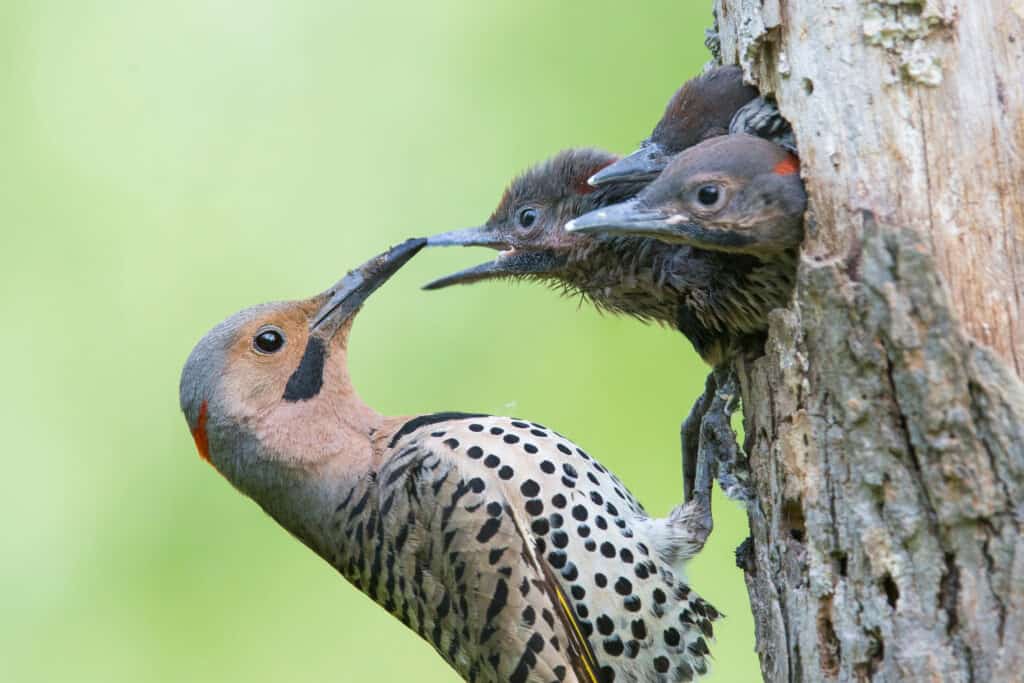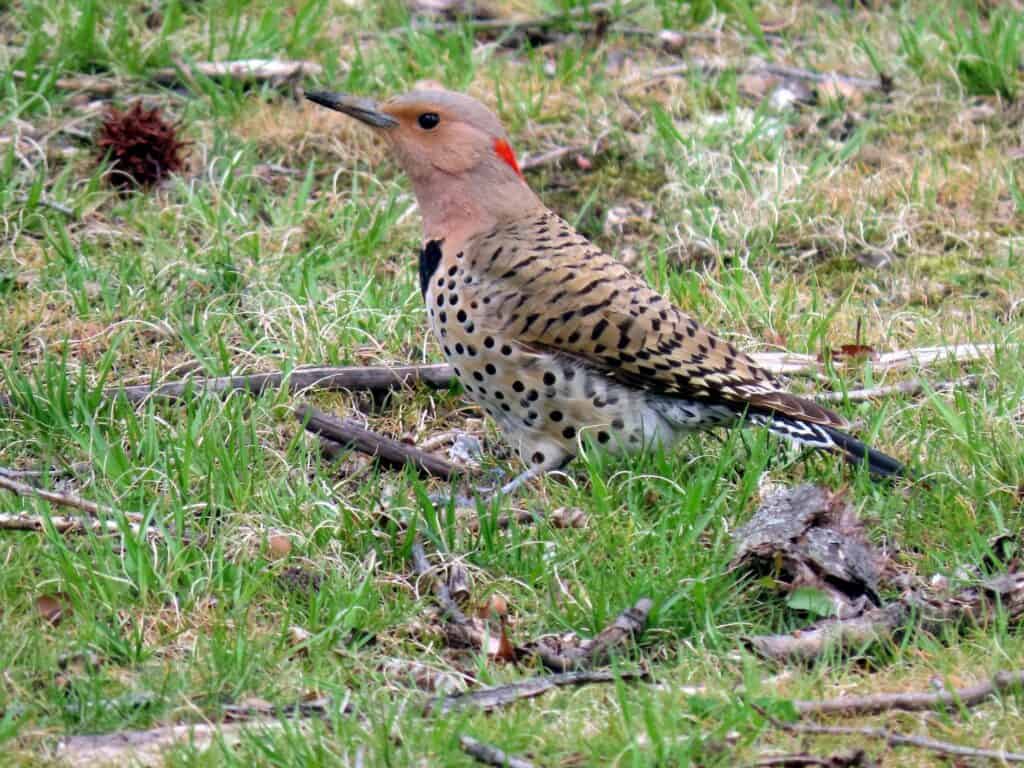Part of the woodpecker family, the northern flicker, often known as the common flicker, is a medium-sized bird you can easily find in North America. It is among the few woodpecker species that migrate, being endemic throughout the majority of North and Central America and the Cayman Islands.
For most bird species, distinguishing the male from the female is quite easy. But when it comes to northern flickers, it’s a little harder than you might think. Unlike other woodpeckers, there is very little difference between the male and female northern flicker. This article will guide you through the main differences between a male and female northern flicker and other interesting facts.
Comparing a Male and Female Northern Flicker
| Male Northern Flicker | Female Northern Flicker | |
|---|---|---|
| Markings | Has a red or black mustache facial stripe | Has no red or black mustache facial stripe |
| Mating Behavior | Territorial | Passive |
| Calls | More active in singing and calls | Less active in singing and calls |
Key Differences Between Male and Female Northern Flickers
Telling a male and female northern flicker apart is not an easy feat as these two share only one remarkable physical distinction – their facial markings. Apart from the apparent difference in their facial markings, males and females of the woodpecker species can be compared based on their mating behavior and calls.
These large gray-brown woodpeckers can be seen foraging ants on backyard lawns and in woodland settings throughout the United States. The red-shafted and yellow-shafted varieties of northern flickers have male and female counterparts that can be difficult to distinguish from a distance. Let’s take a deeper dive into their differences below.
Male vs. Female Northern Flicker: Markings

Male northern flickers have a facial stripe or “mustache” that runs from the bill to the throat and is either red or black.
©Mircea Costina/Shutterstock.com
The primary difference between a male and female northern flicker may be seen in the bird’s facial patterns, making it one of only a few woodpecker species in North America that isn’t black and white. Male birds have a facial stripe or “mustache” that runs from the bill to the throat and is either red or black. In female birds, this pattern is not present.
Female northern flickers feature a black U-shaped bib on their breast, just like the males. Their chest and belly are spotted with black dots, and their wings are banded with black markings. A white patch can be seen above their tail while flying.
No matter the gender, adult northern flickers feature brown wings with black bars. Both sexes are about 11 to 14 inches long and have wingspans of 17 to 21 inches. Although their body weight can vary greatly, it typically ranges from 3 to 5.9 ounces.
Their bodies are normally bigger in the northern regions. For instance, Alaska is home to some of the largest birds, while Grand Cayman Island is home to the tiniest species.
Male vs. Female Northern Flicker: Mating Behavior
To defend their territory and drive out rival males, male northern flickers engage in intricate dance performances and poke each other with their long bills. Females, in contrast, are passive and tend to watch the demonstrations without actively participating.
Beginning in spring and summer, adversaries may engage in a spectacle frequently referred to as a “fencing duel” in front of a potential partner. While tracing a loop or figure-eight sequence in the air and bobbing their heads in time, two male flickers confront each other on a branch with their bills pointing skyward. They frequently make rhythmic wicka cries at the same time. These fights, which are known as “wicka” dances because of the loud, repeating call that goes along with them, may contribute to pair formation.
Unlike traditional woodpecker behavior, northern flickers mostly forage on the ground and may feed alongside sparrows and blackbirds. When startled, flickers frequently perch erect on slender horizontal branches instead of hooking up or around a tree trunk.
Male vs. Female Northern Flicker: Calls

Female northern flicker
©Kevin Manns/Shutterstock.com
While both sexes use sounds and drumming as a means of calling and communication, males are more often heard than females. Male northern flickers hammer upon trees or metal surfaces to produce a loud, uniformly spaced, fast drumming sound. Woodpeckers use drumming the similar way songbirds use singing.
A loud, single-note call from flickers lasts approximately a half-second and frequently sounds like a ‘klee-yer’ or a quiet, repetitive ‘wick-a, wick-a’ call. Northern flickers are extremely vocal birds, producing a variety of recognizable calls, sounds, and extended intervals of intensive drumming. Additionally, northern flickers produce a loud, rumbling rattle with a sharp tone that alternately increases and decreases in volume.
Male vs. Female Northern Flicker: Nesting
Similar to other woodpecker species, northern flickers also build nests. In actuality, they occasionally use old nesting cavities made by other woodpeckers.
Given that both conditions have often been observed, it is uncertain whether the male or female northern flicker ultimately chooses where to build its nest. According to observations, both the male and the female flicker dig nests and participate in periods of heavy excavation work at various stages of the excavation, with female involvement increasing as the hollow nears completion.
For the first four days after hatching, both parents alternately make trips away from the nest to bring food back to care for their newly born.
What Do Northern Flickers Eat?

Northern flickers include insects, bugs, fruits, and seeds in their diet.
©Fiona M. Donnelly/Shutterstock.com
Did you know that northern flickers consume more insects and bugs than most other woodpecker species? Ants and beetles are among their favorite creatures, which they collect from the ground. These woodpeckers frequently pound the ground in search of ants. They can find the ant larvae they love using their tongues, which can dart out up to two inches. However, they also consume fruits and seeds, particularly in the winter.
Up Next:
Male vs Female Pileated Woodpecker: What Are Their Differences
What Do Woodpeckers Eat? 20 Types of Food They Forage and Hunt
The 10 Largest Woodpeckers In The World
The photo featured at the top of this post is ©
Thank you for reading! Have some feedback for us? Contact the AZ Animals editorial team.






